Effect of Zeolite on Shrinkage and Crack Resistance of High-Performance Cement-Based Concrete
Abstract
:1. Introduction
2. Materials and Methods
2.1. Materials
2.2. HPC Compositions
2.3. Testing Methods
3. Results
3.1. Workability of HPC Mixtures
3.2. Internal Relative Humidity of HPC
3.3. Compressive Strength Development
3.4. Pozzolanic Effect of Zeolite in the HPC system
3.5. Autogenous Shrinkage
3.6. Crack Resistance
4. Modelling the Autogenous Shrinkage of HPC Containing Zeolites
4.1. Time Function
4.2. Ultimate Autogenous Shrinkage Strain ( )
4.3. Comparison of the Proposed Model vs. the Fib 2010 Model
5. Conclusions
- The addition of zeolites up to 10% resulted in beneficial effects in both the flowability and compressive strength of high-performance concrete. Higher zeolite content could reduce the workability and the compressive strength, though it was still higher than the one of HPC without zeolite.
- Zeolites with a porous structure helped to reduce the drying of HPC due to self-desiccation and continuous hydration of a low w/b ratio cementitious matrix. The higher the zeolite content, the smaller the RH reduction in HPC. Consequently, the autogenous shrinkage tended to decrease with the increase in zeolite content and its particle size because of higher water absorption capacity in its structure. In addition, the rate of the autogenous shrinkage development at early ages decreased with the increase in zeolite content. A sharp increasing rate in autogenous shrinkage was observed within a short period of 3 days, while it was prolonged up to 12 days for the sample with 15% zeolite.
- The shrinkage reduction resulted in a lower potential of shrinkage cracking of HPC containing zeolites. The first shrinkage cracks occurred at 1.3 days for the reference sample, whereas the shrinkage cracks only appeared at 6.8 days and 12.5 days for HPC mixtures with 10% and 15% zeolite, respectively.
- An improved model for HPC containing zeolites has been proposed by introducing new parameters accounting for the zeolite content and its particle size. It appeared that the proposed model was able to capture the autogenous shrinkage behaviour of HPC with or without zeolite, while the fib 2010 model underestimated the autogenous shrinkage of HPC containing less than 10% zeolite replacement. Note that when applying the proposed model to other HPC with different raw material properties and compositions, the model may need to be recalibrated to increase the accuracy.
Author Contributions
Funding
Conflicts of Interest
References
- Patel, R.A.; Phung, Q.T.; Seetharam, S.C.; Perko, J.; Jacques, D.; Maes, N.; De Schutter, G.; Ye, G.; van Breugel, K. Diffusivity of saturated ordinary Portland cement-based materials: A critical review of experimental and analytical modelling approaches. Cement Concr. Res. 2016, 90, 52–72. [Google Scholar] [CrossRef]
- Jensen, O.M.; Hansen, P.F. Autogenous deformation and RH-change in perspective. Cement Concr. Res. 2001, 31, 1859–1865. [Google Scholar] [CrossRef]
- Holt, E.E. Early Age Autogenous Shrinkage of Concrete; Technical Research Center of Finland: Espoo, Finland, 2001. [Google Scholar]
- Tazawa, E.I. Autogenous Shrinkage of Concrete. Technical Committee Report on Autogenous Shrinkage of Concrete; Japan Concrete Institute E & FN Spon: London, UK, 1999; p. 409. [Google Scholar]
- Ahmadi, B.; Shekarchi, M. Use of natural zeolite as a supplementary cementitious material. Cement Concr. Compos. 2010, 32, 134–141. [Google Scholar] [CrossRef]
- Mumpton, F. Mineralogy and geology of natural zeolites. N. Y. Repr. Mineral. Soc. Am. Rev. Mineral. 2018, 4, 233. [Google Scholar]
- Lv, Y.; Ye, G.; de Schutter, G. Investigation on the potential utilization of zeolite as an internal curing agent for autogenous shrinkage mitigation and the effect of modification. Constr. Build Mater. 2019, 198, 669–676. [Google Scholar] [CrossRef]
- Nguyen, V.T.; Ye, G.; Breugel, K.V.; Fraaij, A.L.A.; Bui, D.D. The study of using rice husk ash to produce ultra high performance concrete. Constr. Build Mater. 2011, 25, 2030–2035. [Google Scholar] [CrossRef]
- Tuan, N.V.; Guang, Y.; Breugel, K.V. Effect of rice husk ash on autogenous shrinkage of ultra high performance concrete. In Proceedings of the International RILEM Conference on Use of Superabsorbent Polymers and Other New Additives in Concrete, Technical University of Denmark, Lyngby, Denmark, 15–18 August 2010; p. 12. [Google Scholar]
- Tuan, N.V.; Guang, Y.; Breugel, K.V. Mitigation of early age shrinkage of ultra high performance concrete by using rice husk ash. In Proceedings of the 3rd International Symposium on UHPC and Nanotechnology for High Performance Construction Materials: Ultra-High Performance Concrete and Nanotechnology in Construction (HIPERMAT-2012), Kassel, Germany, 7–9 March 2012; pp. 341–348. [Google Scholar]
- Liu, K.; Yu, R.; Shui, Z.; Li, X.; Ling, X.; He, W.; Yi, S.; Wu, S. Optimization of autogenous shrinkage and microstructure for Ultra-high performance concrete (UHPC) based on appropriate application of porous pumice. Constr. Build Mater. 2019, 214, 369–381. [Google Scholar] [CrossRef]
- Dudziak, L.; Mechtcherine, V. Mitigation of Volume Changes of Ultra-High Performance Concrete (UHPC) by Using Super Absorbent Polymers. In Proceedings of the 2nd International Symposium on Ultra High Performance Concrete, Kassel, Germany, 5–7 March 2008; pp. 425–432. [Google Scholar]
- Kovler, K.; Jensen, O. Internal curing of concrete, state-of-the-art Report of RILEM Technical Committee 196-ICC. RILEM Rep. 2007, 41, 161. [Google Scholar]
- Liu, J.; Shi, C.; Ma, X.; Khayat, K.H.; Zhang, J.; Wang, D. An overview on the effect of internal curing on shrinkage of high performance cement-based materials. Constr. Build Mater. 2017, 146, 702–712. [Google Scholar] [CrossRef] [Green Version]
- Kovler, K.; Roussel, N. Properties of fresh and hardened concrete. Cement Concr. Res. 2011, 41, 775–792. [Google Scholar] [CrossRef]
- Van Tuan, N.; Ye, G.; van Breugel, K. Internal curing of ultra high performance concrete by using rice husk ash. In Proceedings of the International RILEM Conference on Material Science, Aachen, Germany, 6–10 September 2010; pp. 265–274. [Google Scholar]
- Bentz, D.P.; Jensen, O.M. Mitigation strategies for autogenous shrinkage cracking. Cement Concr. Compos. 2004, 26, 677–685. [Google Scholar] [CrossRef]
- Sabet, F.A.; Libre, N.A.; Shekarchi, M. Mechanical and durability properties of self consolidating high performance concrete incorporating natural zeolite, silica fume and fly ash. Constr. Build Mater. 2013, 44, 175–184. [Google Scholar] [CrossRef]
- Pezeshkian, M.; Delnavaz, A.; Delnavaz, M. Effect of natural zeolite on mechanical properties and autogenous shrinkage of ultrahigh-performance concrete. J. Mater. Civil. Eng. 2020, 32, 04020093. [Google Scholar] [CrossRef]
- Pezeshkian, M.; Delnavaz, A.; Delnavaz, M. Development of UHPC mixtures using natural zeolite and glass sand as replacements of silica fume and quartz sand. Eur. J. Environ. Civ. Eng. 2019, 1–16. [Google Scholar] [CrossRef]
- Beton, C.E.I.D. FIB model code for concrete structures. In International Federation for Structural Concrete (FIB); Ernst: Washington, DC, USA, 2010. [Google Scholar]
- Vietnamese Standard TCVN 2682:2009: Portland Cements-Specifications; Vietnam Standard and Quality Institute: Hanoi, Vietnam, 2009.
- BS4551. Methods of Testing Mortars, Screeds and Plasters-Part 1. Physical Testing; British Standards Institution: London, UK, 1998. [Google Scholar]
- ASTM C109. Standard Test Method for Compressive Strength of Hydraulic Cement Mortars; ASTM International: West Conshohocken, PA, USA, 2016. [Google Scholar]
- ASTM C1581. Standard Test Method for Determining Age at Cracking and Induced Tensile Stress Characteristics of Mortar and Concrete under Restrained Shrinkage; ASTM International: West Conshohocken, PA, USA, 2004. [Google Scholar]
- Xincheng, P. Super High Strength High Performance Concrete; CRC Press: Boca Raton, FL, USA, 2012. [Google Scholar]
- De Sensale, G.R.; Goncalves, A.F. Effects of fine LWA and SAP as internal water curing agents. Int. J. Concr. Struct. Mater. 2014, 8, 229–238. [Google Scholar] [CrossRef]
- Lura, P.; van Breugel, K. Volume changes of lightweight aggregate concrete at early ages: The effect of particle size distribution of the lightweight aggregates in experiments and numerical simulations. In Proceedings of the 9th International Conference on Durability of Building Materials and Components, Brisbane, Australia, 17–20 March 2002; p. 10. [Google Scholar]
- Phung, Q.T.; Maes, N.; de Schutter, G.; Jacques, D.; Ye, G. Determination of water permeability of cementitious materials using a controlled constant flow method. Constr. Build Mater. 2013, 47, 1488–1496. [Google Scholar] [CrossRef]
- Tuan, N.V. Rice Husk Ash as a Mineral Admixture for Ultra High Performance Concrete. Ph.D. Thesis, Technical University of Delft, Delft, The Netherlands, 2011. [Google Scholar]
- Van, V.T.A. Rice husk ash as both pozzolanic admixture and internal curing agent in ultra-high performance concrete. Cement Concr. Compos. 2014, 53, 270–278. [Google Scholar] [CrossRef]
- Gardner, N.J.; Lockman, M.J. Design provisions for drying shrinkage and creep of normal-strength concrete. Mater. J. 2001, 98, 159–167. [Google Scholar]
- Yang, K.H.; Mun, J.S.; Shim, H.J. Shrinkage of heavyweight magnetite concrete with and without fly ash. Constr. Build Mater. 2013, 47, 56–65. [Google Scholar] [CrossRef]
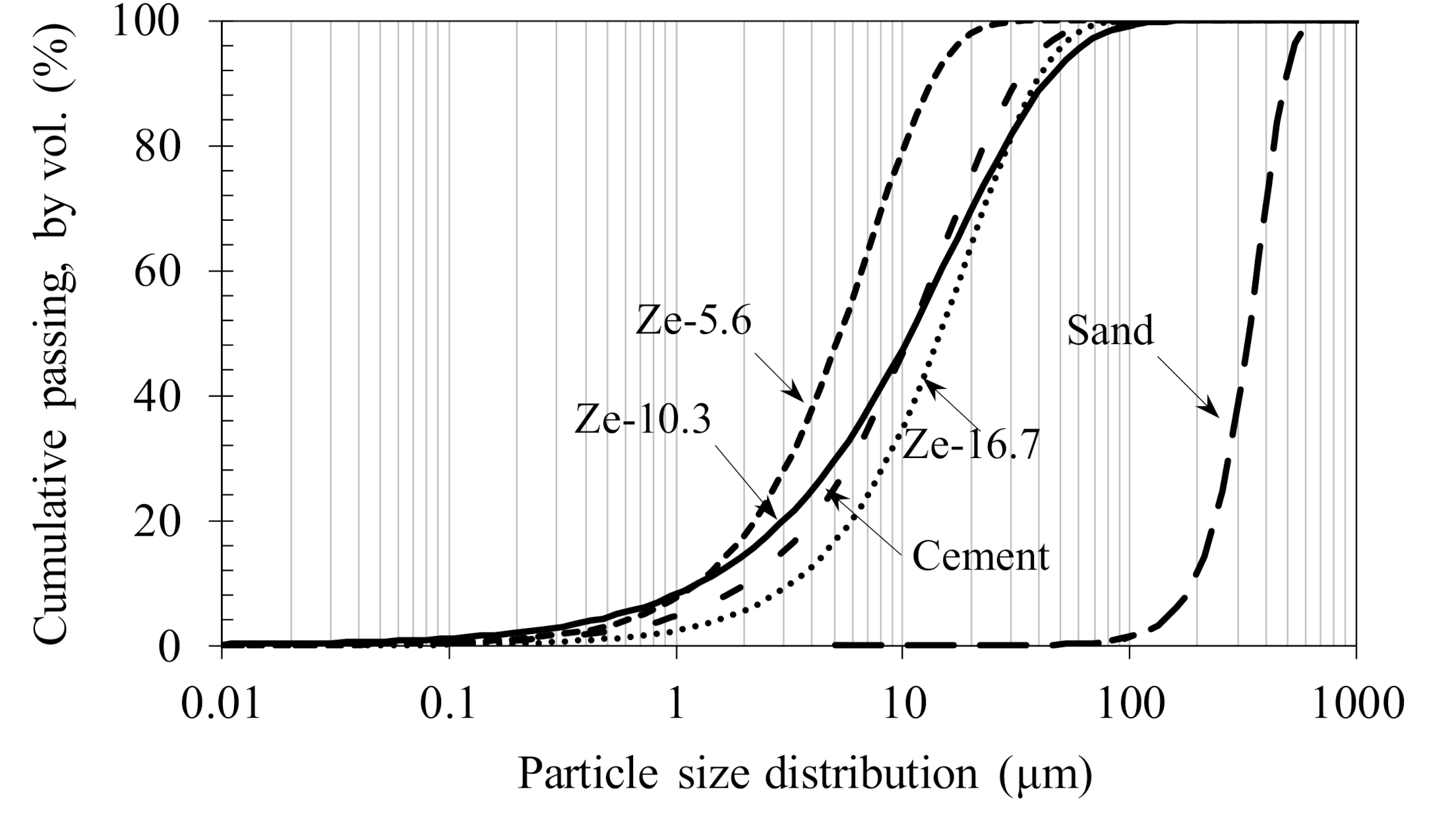
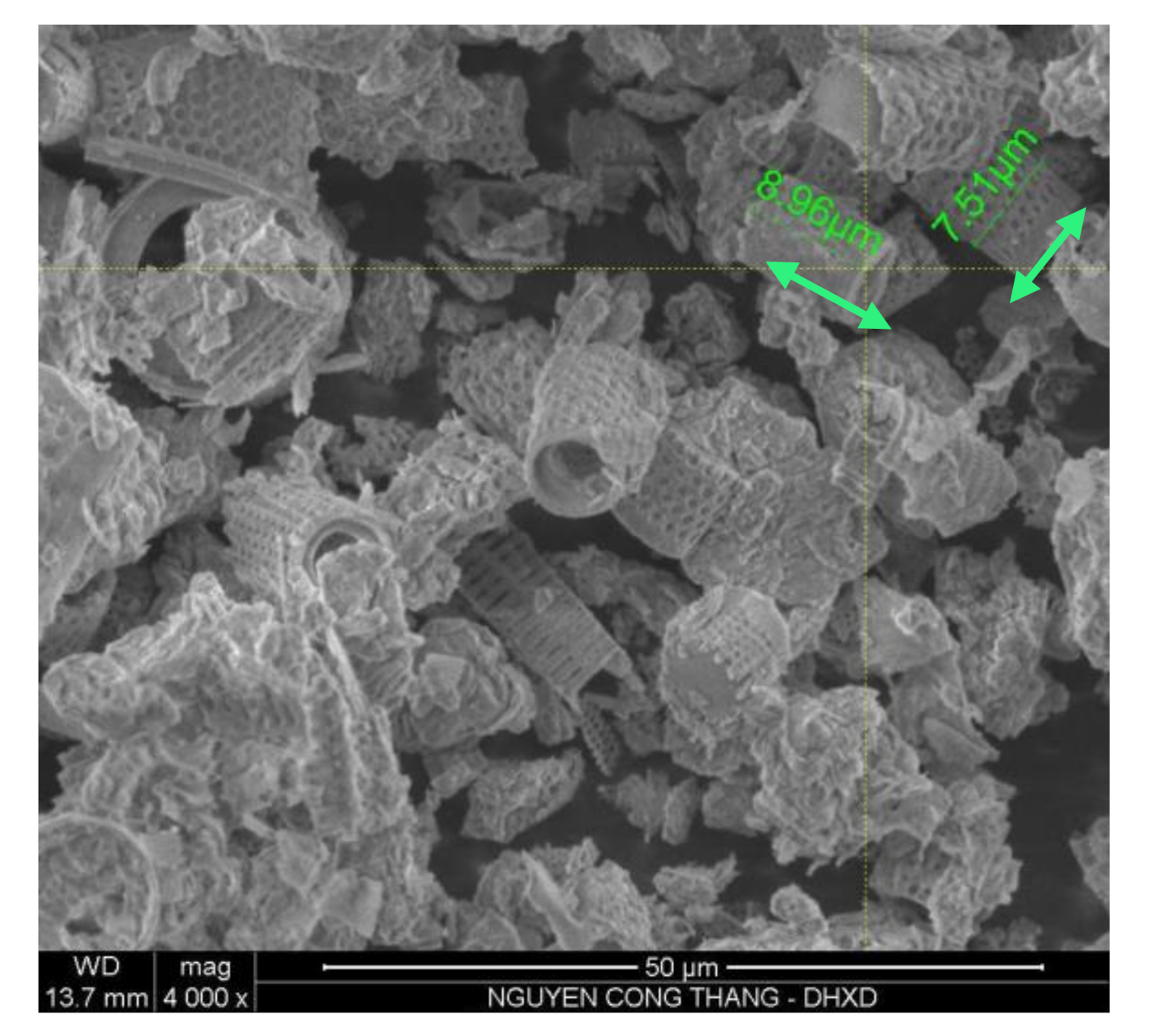
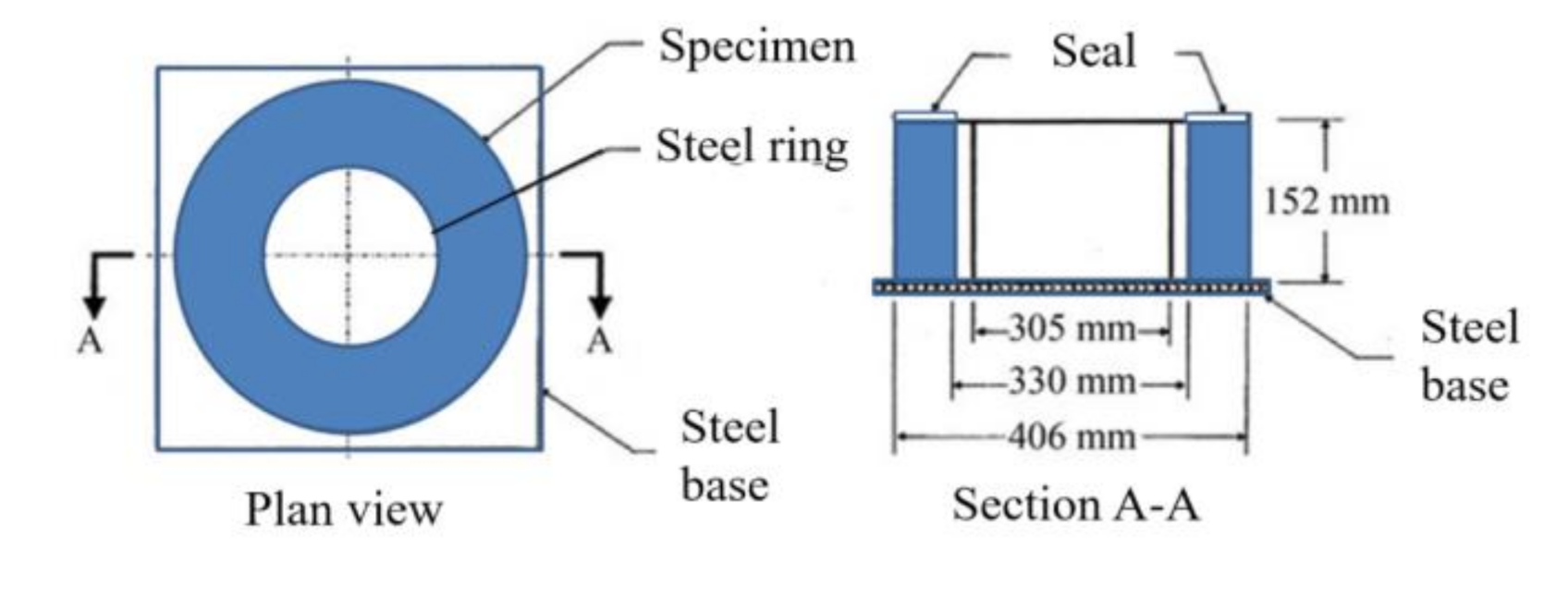
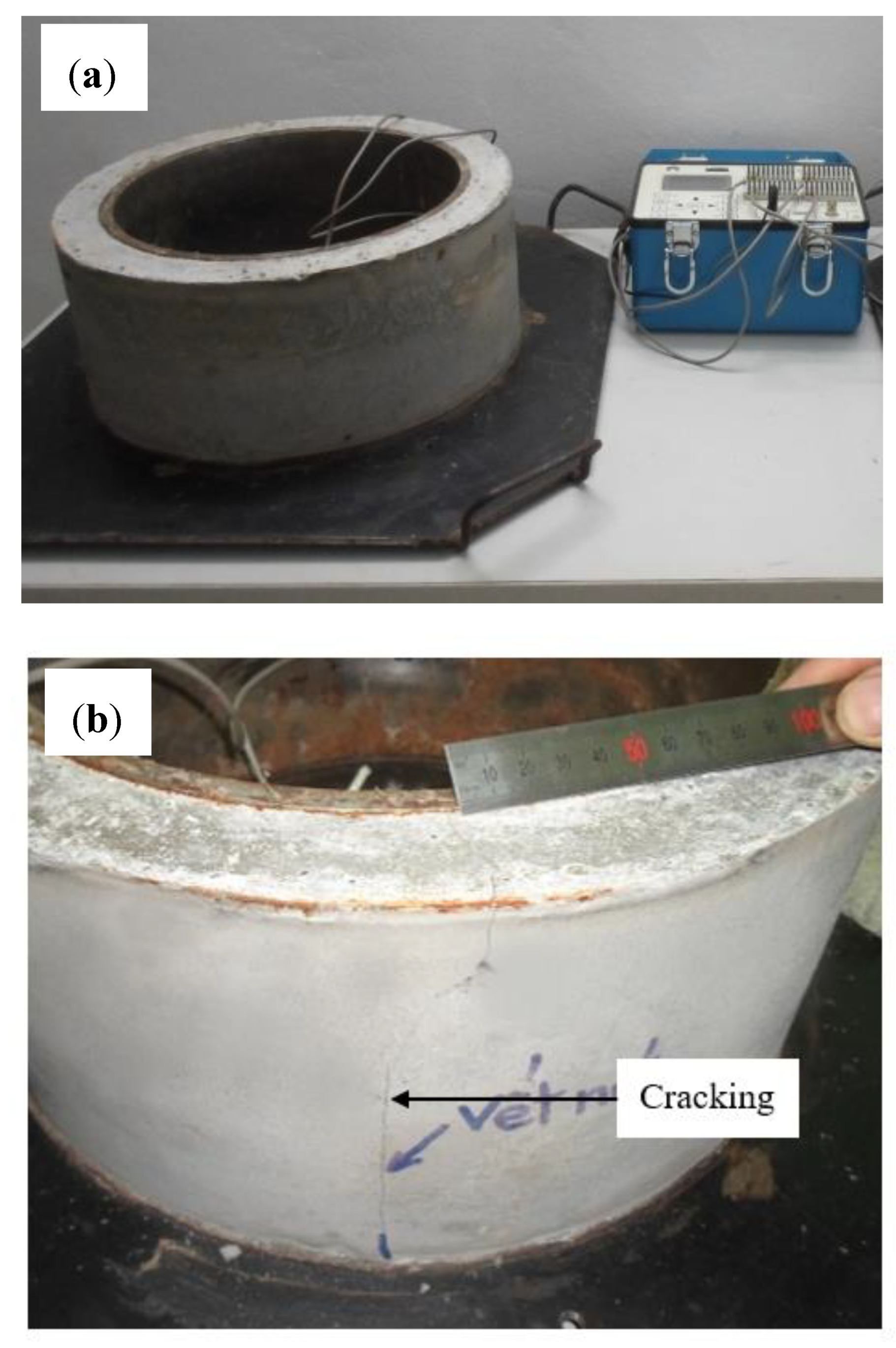
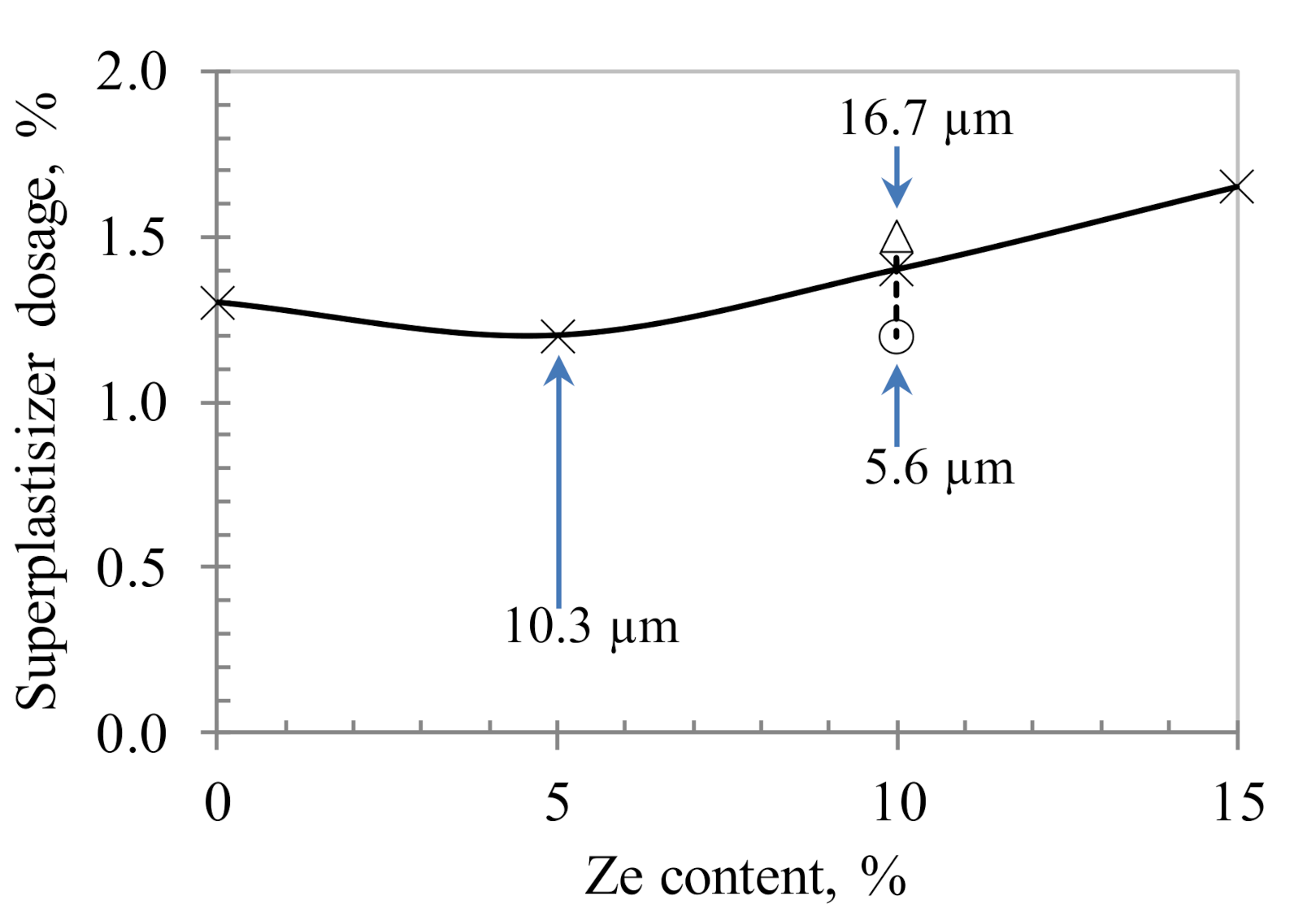
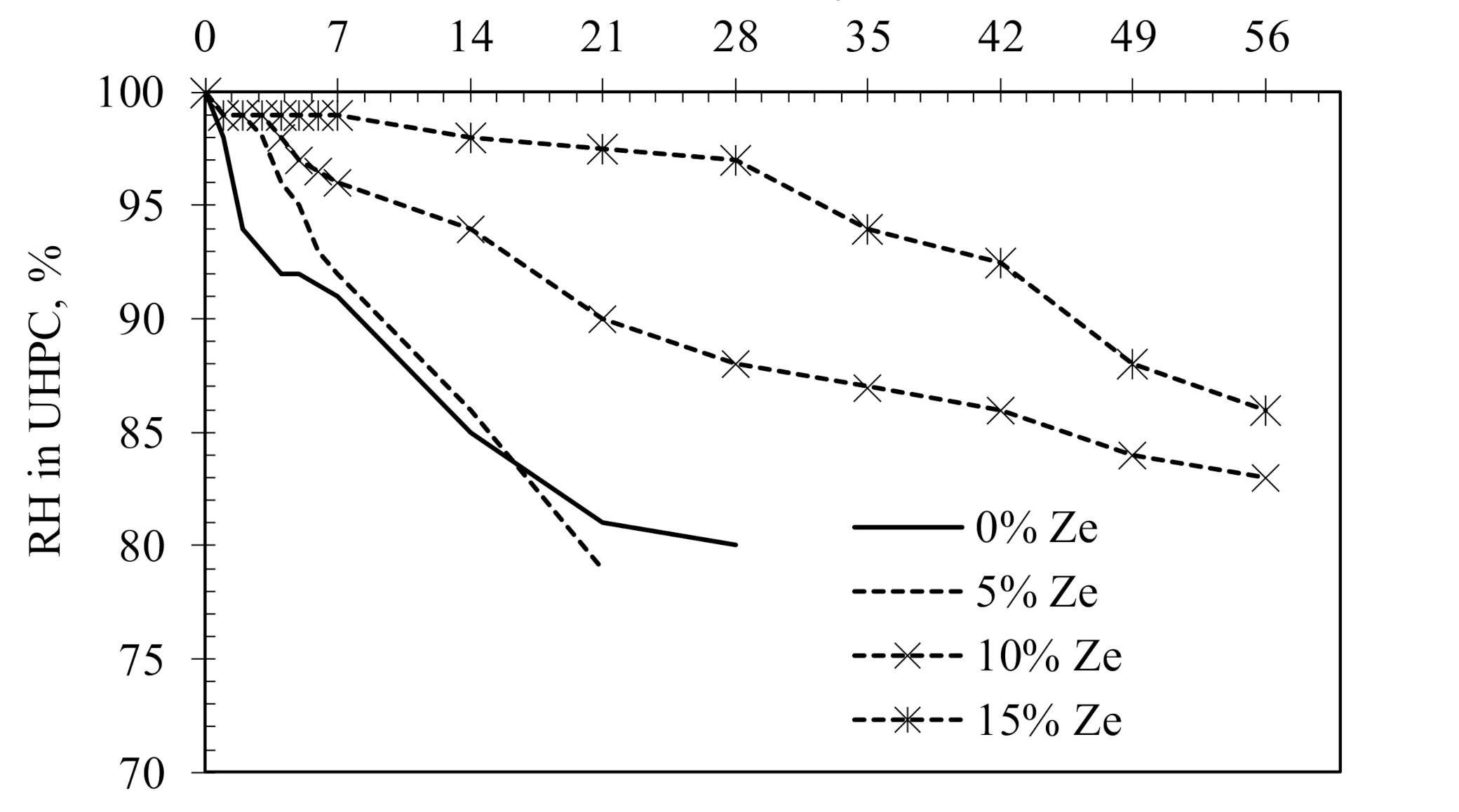
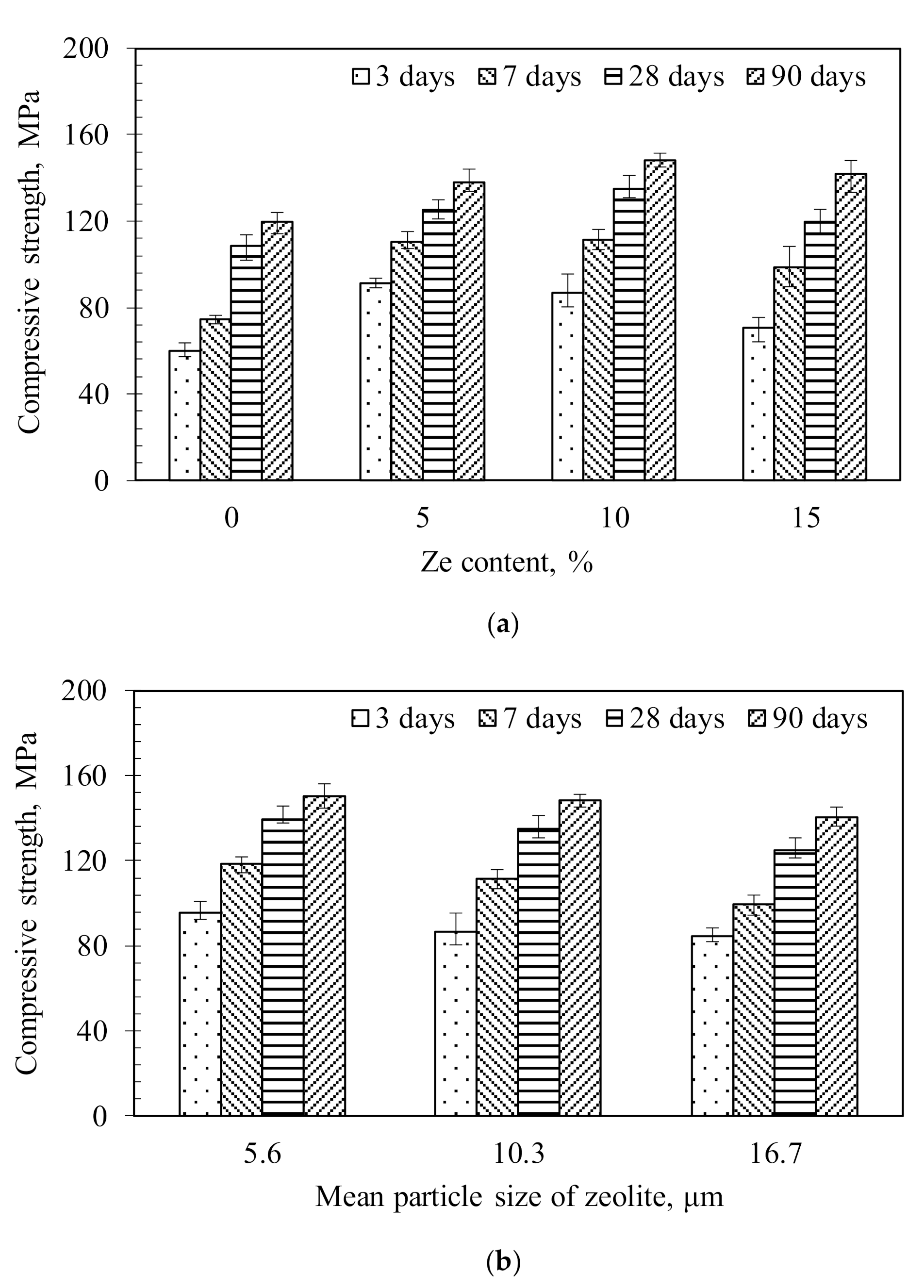

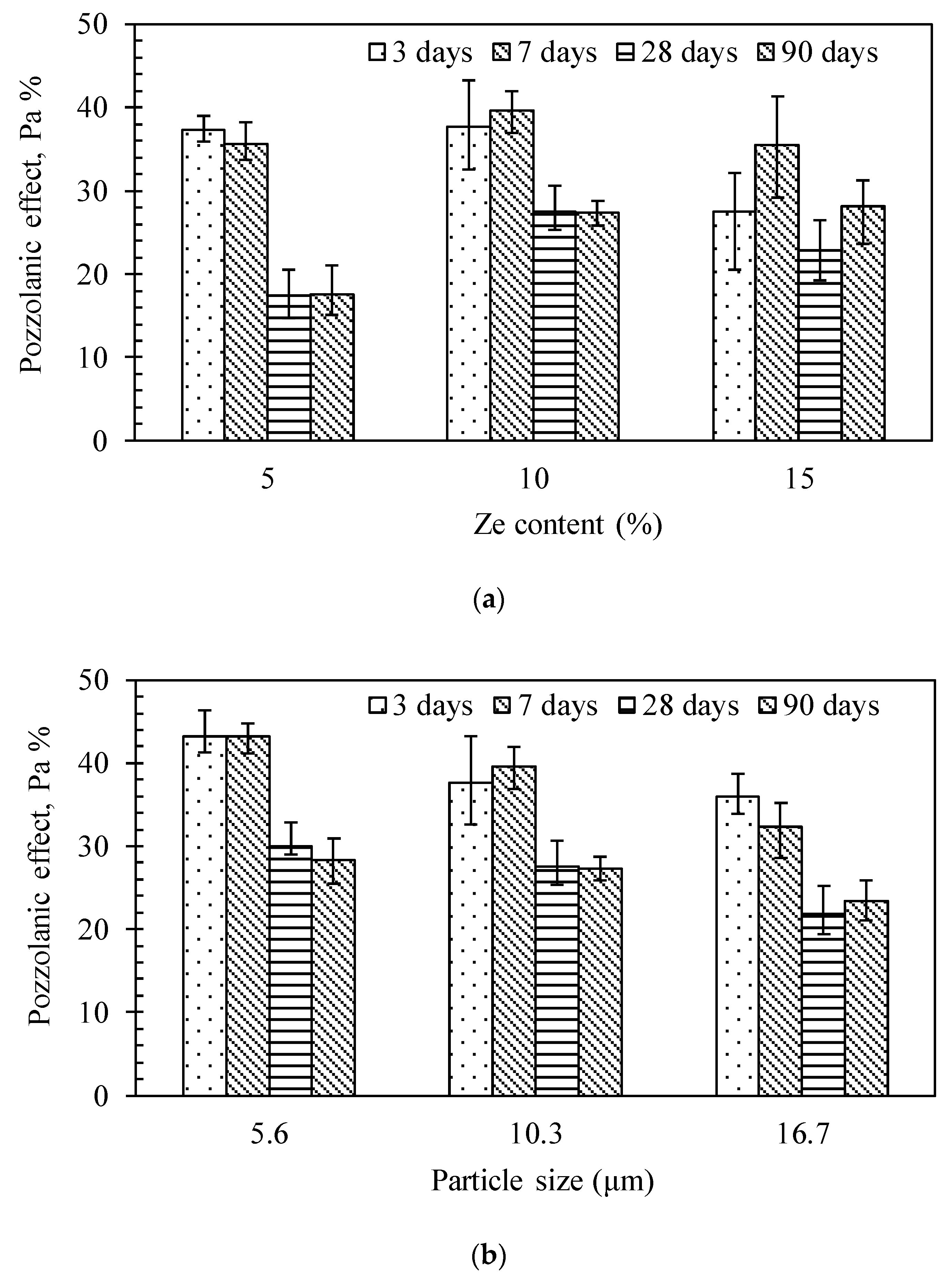
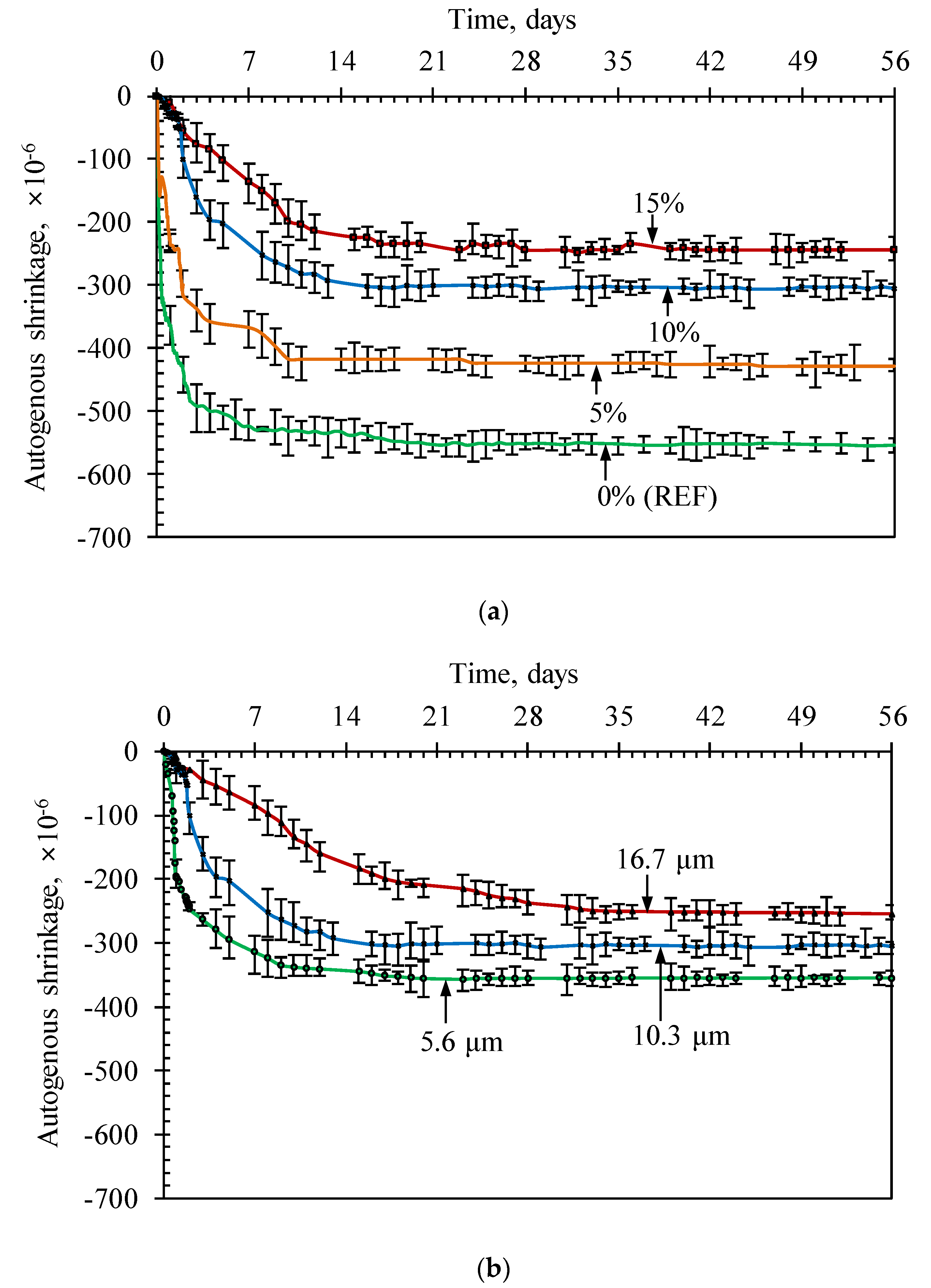


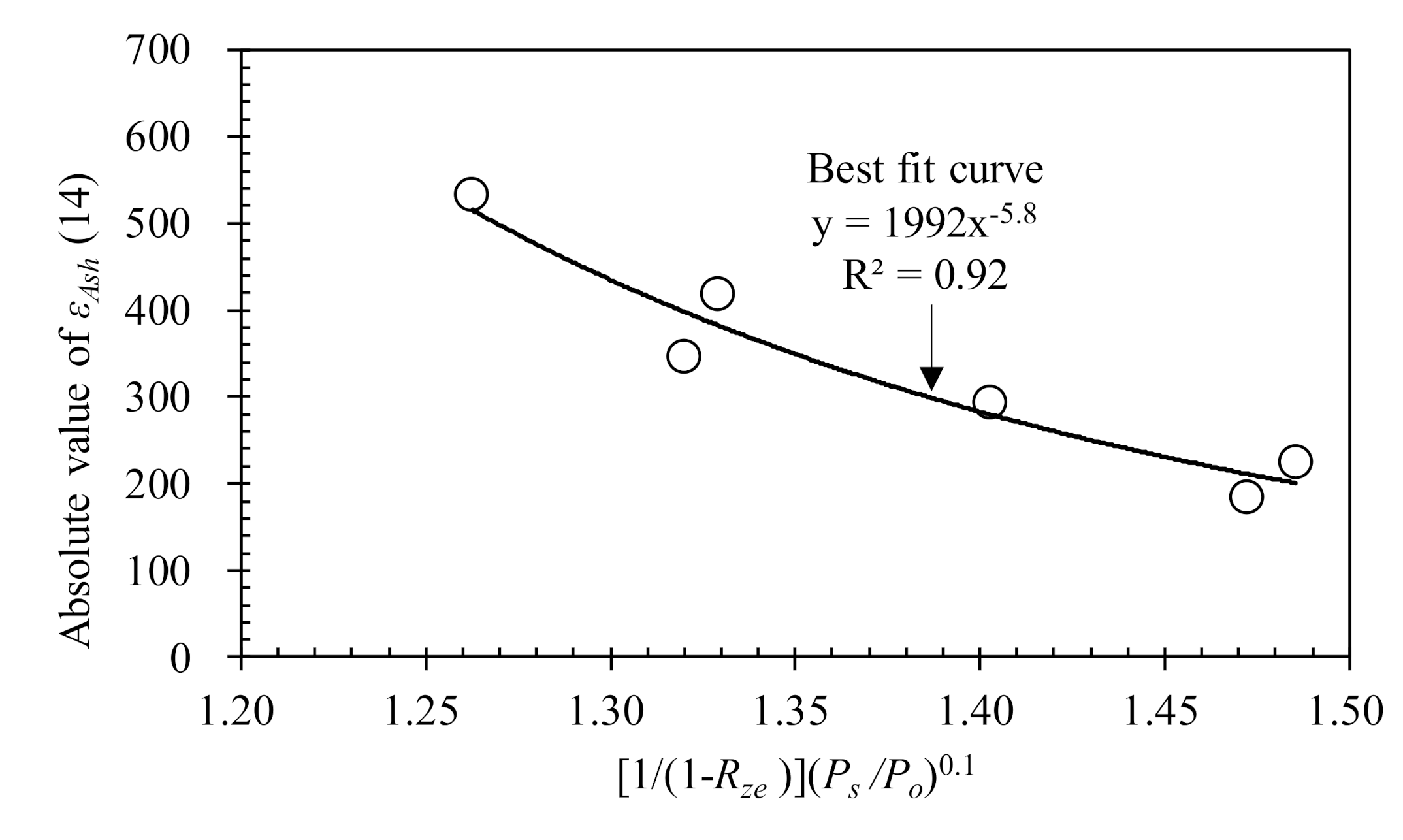
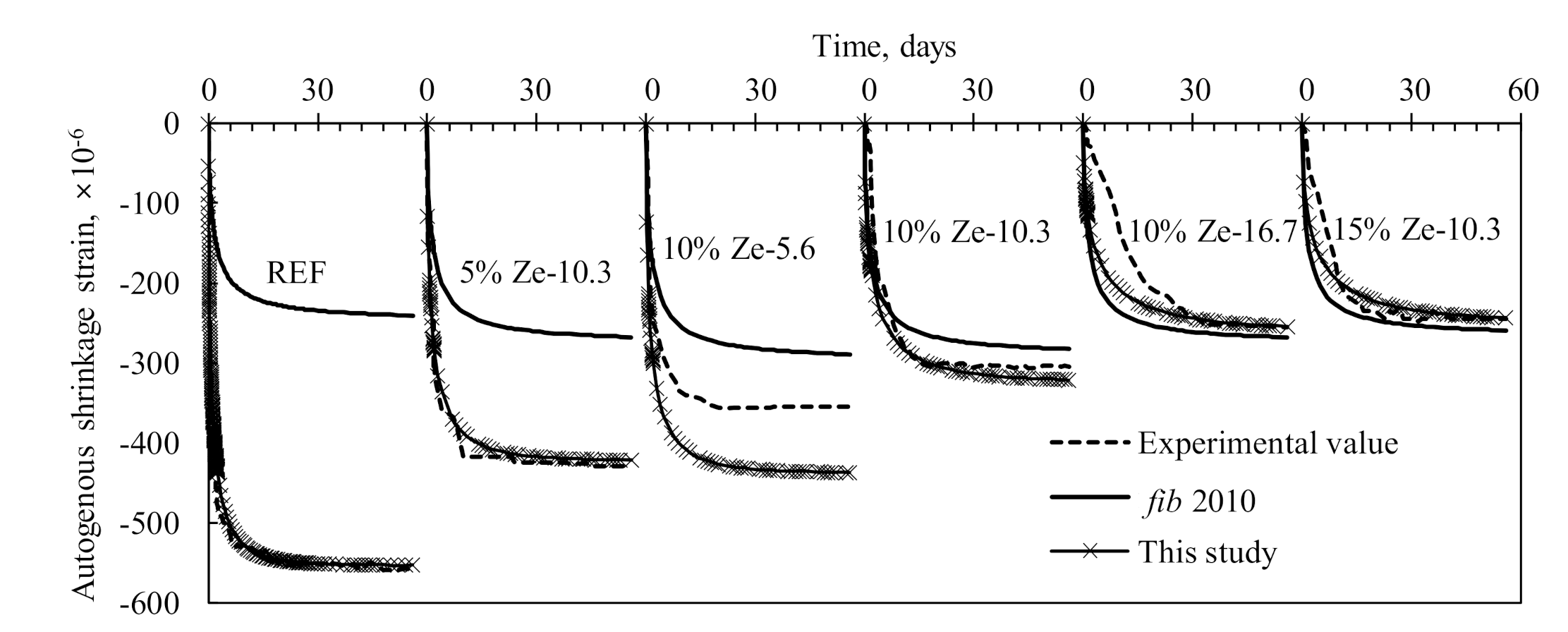
| Properties | Cement | Ze-5.6 | Ze-10.3 | Ze-16.7 |
|---|---|---|---|---|
| Density, g/cm3 | 3.15 | 2.18 | ||
| Mean particle size, μm | 13.9 | 5.6 | 10.3 | 16.7 |
| Materials | SiO2 | Fe2O3 | Al2O3 | CaO | MgO | Na2O | K2O | SO3 | L.O.I |
|---|---|---|---|---|---|---|---|---|---|
| Cement, wt.% | 35.58 | 0.68 | 12.76 | 42.82 | 7.67 | 0.24 | 0.25 | N/A | N/A |
| Zeolite, wt.% | 60.25 | 1.9 | 18.45 | 4.11 | 1.12 | 1.66 | 1.18 | N/A | 11.33 |
| No. | w/b | s/b | Ze, wt.% by Binder | Solid SP, wt.% by Binder | S, kg/m3 | Ze, kg/m3 | C, kg/m3 | SP, kg/m3 | Water, kg/m3 | Mean Particle Size of Ze, μm |
|---|---|---|---|---|---|---|---|---|---|---|
| 1 | 0.18 | 1 | 0 | 1.30 | 1143 | 0 | 1143 | 42.5 | 191 | 10.3 |
| 2 | 0.18 | 1 | 5 | 1.20 | 1139 | 56.9 | 1082 | 39.0 | 193 | 10.3 |
| 3 | 0.18 | 1 | 10 | 1.40 | 1134 | 113.4 | 1021 | 45.4 | 188 | 10.3 |
| 4 | 0.18 | 1 | 15 | 1.65 | 1130 | 169.5 | 961 | 53.3 | 182 | 10.3 |
| 5 | 0.18 | 1 | 10 | 1.20 | 1134 | 113.4 | 1021 | 38.9 | 192 | 5.6 |
| 6 | 0.18 | 1 | 10 | 1.50 | 1134 | 113.4 | 1021 | 48.6 | 186 | 16.7 |
© 2020 by the authors. Licensee MDPI, Basel, Switzerland. This article is an open access article distributed under the terms and conditions of the Creative Commons Attribution (CC BY) license (http://creativecommons.org/licenses/by/4.0/).
Share and Cite
Thang, N.C.; Tuan, N.V.; Yang, K.-H.; Phung, Q.T. Effect of Zeolite on Shrinkage and Crack Resistance of High-Performance Cement-Based Concrete. Materials 2020, 13, 3773. https://doi.org/10.3390/ma13173773
Thang NC, Tuan NV, Yang K-H, Phung QT. Effect of Zeolite on Shrinkage and Crack Resistance of High-Performance Cement-Based Concrete. Materials. 2020; 13(17):3773. https://doi.org/10.3390/ma13173773
Chicago/Turabian StyleThang, Nguyen Cong, Nguyen Van Tuan, Keun-Hyeok Yang, and Quoc Tri Phung. 2020. "Effect of Zeolite on Shrinkage and Crack Resistance of High-Performance Cement-Based Concrete" Materials 13, no. 17: 3773. https://doi.org/10.3390/ma13173773








